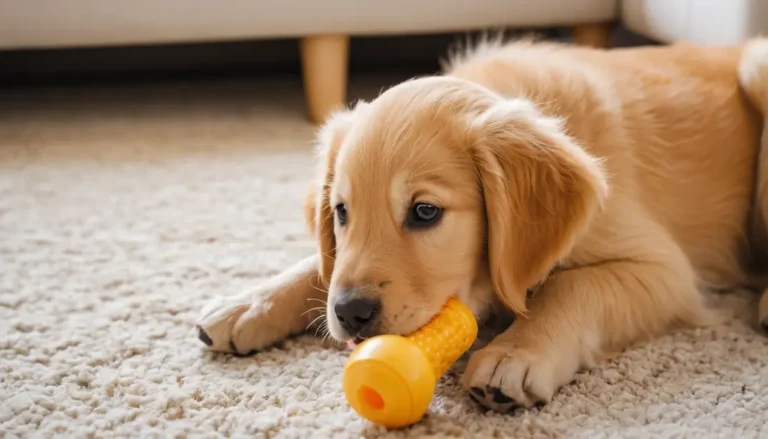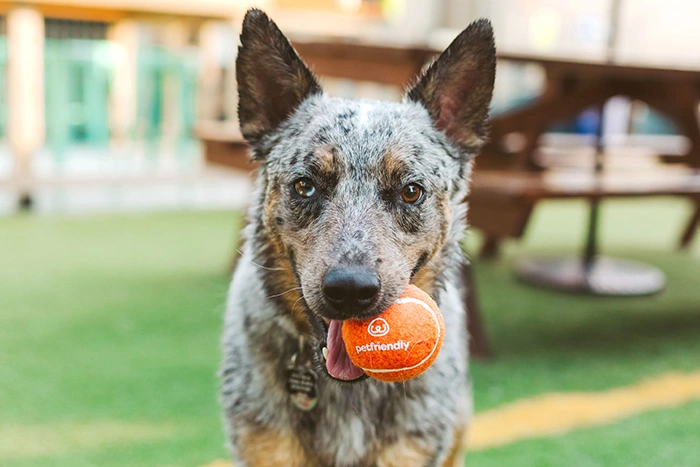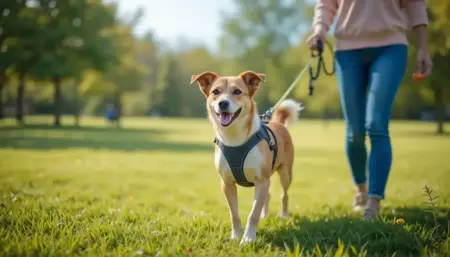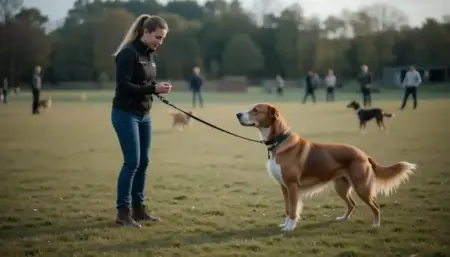Puppy mouthing control teaches dogs to moderate bite force during play, preventing future aggression. Start training at 8-10 weeks using consistent redirection and positive reinforcement when your puppy bites.
Withdraw attention immediately after hard bites and provide appropriate chew toys to redirect energy. Proper bite inhibition is crucial for developing safe, well-socialized adult dogs who understand human interaction boundaries.
Most puppy mouthing is normal behavior, but without proper training, it can escalate into problematic biting.
Over 80% of dogs under 1 year old exhibit mouthing behavior, making early intervention essential for harmonious human-dog relationships.
This guide provides science-backed techniques to transform rough play into gentle interaction through positive, effective puppy mouthing control strategies.
Why Puppy Mouthing Control Matters
Puppy mouthing control isn’t just about preventing painful nips—it’s foundational for your dog’s social development and your family’s safety.
During the critical socialization window (first 12-16 weeks), puppies learn bite inhibition through interactions with littermates and humans.
Without proper training, puppies fail to develop the crucial ability to control jaw pressure, potentially leading to dangerous bites as adults.
Statistics show that 80% of dogs under 6 months exhibit mouthing behavior compared to just 39.6% of older dogs, highlighting why early intervention is critical.
The Consequences of Ignoring Mouthing Behavior
When puppy mouthing control isn’t established early, several significant problems can develop:
- Increased bite severity: Dogs without proper bite inhibition may cause serious injuries during play or stressful situations
- Social isolation: Dogs who bite too hard often get excluded from playgroups and social events
- Rehoming risks: Uncontrolled mouthing is a leading reason for puppy surrenders to shelters
- Training setbacks: Puppies who haven’t learned bite control often struggle with other obedience training
The American Veterinary Society of Animal Behavior emphasizes that bite inhibition training should be considered standard care during puppy development.
Unlike common misconceptions, this isn’t about stopping all mouth exploration—it’s about teaching appropriate pressure through consistent, positive reinforcement methods that build trust rather than fear.
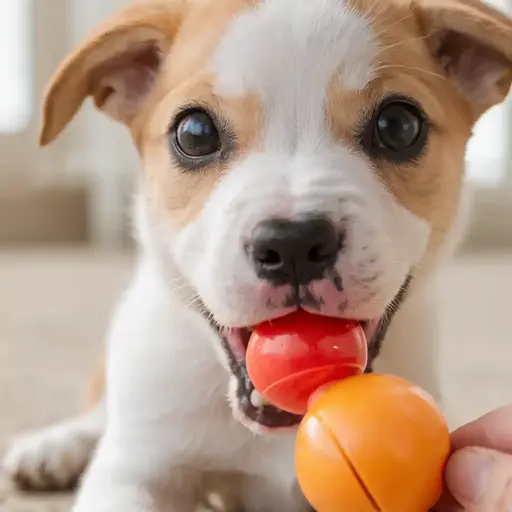
The Science Behind Bite Inhibition
Bite inhibition develops naturally when puppies play with littermates who yelp and stop playing when bites are too hard.
This biological feedback system teaches pups to moderate their bite force. When separated from their litter too early (before 8 weeks), puppies miss this critical learning period, making human intervention essential for proper puppy mouthing control.
How Puppies Learn Bite Pressure
Puppies progress through three distinct stages of bite inhibition:
- Initial learning phase (8-12 weeks): Puppies discover that hard bites end playtime
- Refinement phase (3-6 months): Puppies learn to apply minimal pressure during mouth contact
- Maintenance phase (6+ months): Dogs consistently use inhibited bites during all interactions
The primary and most important time for developing this skill is during the first three months of life, when neural pathways are most adaptable.
During this sensitive period, puppies should experience diverse social situations while learning appropriate mouth manners—never through punishment, but through positive reinforcement of desired behaviors.
The American Veterinary Society of Animal Behavior specifically advises against punishment-based techniques, noting they often increase fear and anxiety while decreasing trust.
Step-by-Step Puppy Mouthing Control Training
Effective puppy mouthing control requires consistency, patience, and understanding of canine communication.
Start training as soon as you bring your puppy home (ideally between 8-10 weeks) when learning capacity is highest.
The following method combines proven techniques from veterinary behaviorists with practical owner experience.
The Redirect-and-Reward Method
This positive reinforcement approach yields the best long-term results for puppy mouthing control:
- Recognize pre-bite cues: Watch for stiffening, intense staring, or playful “play bow” positions that often precede mouthing
- Redirect immediately: When mouthing begins, calmly offer an appropriate chew toy while saying, “Bite this.”
- Reward gentle contact: Praise and treat when your puppy mouths the toy instead of your skin
- End play for hard bites: If your puppy bites too hard, say “Ouch!” in a high-pitched voice and immediately stop all interaction for 10-20 seconds.
Gently teaching your puppy that biting hard ends fun interaction, creates natural consequences without fear or confusion.
This method mirrors how littermates teach each other bite inhibition—through immediate but non-punitive feedback.
Consistency is crucial; all family members must respond identically to mouthing behavior to prevent mixed signals.
Structured Training Schedule
| Training Phase | Daily Duration | Key Focus | Expected Timeline |
|---|---|---|---|
| Foundation | 3-5 minutes, 5x/day | Redirecting to toys | Days 1-7 |
| Pressure Control | 5-7 minutes, 4x/day | Gentle mouthing rewards | Weeks 2-3 |
| Distraction Training | 7-10 minutes, 3x/day | Maintaining control with stimuli | Weeks 4-6 |
| Generalization | Ongoing, integrated | Consistent behavior in all situations | Months 2-4 |
Begin each session with calm interaction to prevent overexcitement, which often triggers mouthing.
End sessions while your puppy is still engaged to maintain positive associations.
Research shows that conditional discrimination training—where puppies learn to control unwanted behaviors through environmental cues—is highly effective for managing mouthing frequency.
Always conclude training with success, even if you need to simplify the task to achieve it.

Common Puppy Mouthing Control Mistakes
Even well-intentioned owners make errors that undermine puppy mouthing control efforts. Recognizing these pitfalls prevents wasted effort and potential setbacks in your training journey.
Mistake #1: Inconsistent Responses to Mouthing
The most frequent error involves mixed signals—sometimes allowing mouthing during play, then punishing it later.
Puppies thrive on predictability; varying responses confuse them and prolong the learning process.
Over 75% of new puppy owners admit to inconsistent training approaches during the first month.
For effective puppy mouthing control, every family member must follow the same protocol: immediate redirection for gentle mouthing and brief time-outs for hard bites.
Mistake #2: Using Punishment-Based Techniques
Many owners instinctively yell, slap, or pin puppies who bite too hard. This approach backfires spectacularly.
The standard of care for veterinary behavior specialists explicitly states that punishment should never be a first-line treatment for behavior problems.
Punishment creates fear-based associations that often increase aggression while damaging your bond.
Instead of teaching bite control, it teaches puppies to suppress warning signs before biting—making future bites more dangerous.
Mistake #3: Not Starting Early Enough
Delaying training until mouthing becomes severe creates unnecessary challenges. The critical window for bite inhibition closes around 16 weeks, making early intervention essential.
Waiting until your puppy is “too big to nip” misses the biological period when learning occurs most naturally.
Starting puppy mouthing control at 8-10 weeks—when you bring your puppy home—aligns with veterinary recommendations for optimal socialization.
Mistake #4: Misinterpreting Mouthing as Aggression
Most puppy mouthing stems from exploration and play, not aggression. Overreacting by isolating or excessively correcting your puppy creates unnecessary fear.
Only when mouthing occurs with stiff body posture, growling, or avoidance should you consult a veterinary behaviorist.
Understanding the difference between normal play biting and concerning behavior prevents misdirected training efforts.
When Puppy Mouthing Signals Bigger Issues
While most mouthing is developmentally normal, certain patterns indicate underlying problems requiring professional intervention.
Recognizing these red flags ensures timely support while preventing escalation of puppy mouthing control challenges.
Warning Signs Requiring Professional Help
Consult a certified veterinary behaviorist if your puppy exhibits:
- Targeted aggression: Biting only specific people (especially children) while being gentle with others
- Pain-related biting: Mouthing when touched in certain areas, suggesting undiagnosed discomfort
- Fear-based reactions: Biting when approached, accompanied by cowering or avoidance
- No pressure modulation: Consistently hard bites regardless of feedback
Some puppies bite out of fear or frustration rather than typical play behavior, which can signal future aggression problems.
These cases require specialized assessment—never assume problematic mouthing will “just grow out of it.”
Early intervention by a professional creates better outcomes than waiting until behaviors become entrenched.
The Socialization Connection
Proper socialization directly impacts successful puppy mouthing control. Puppies should receive a minimum of one vaccine set at least 7 days before attending socialization classes to safely experience diverse environments.
Limited social exposure creates under-socialized dogs who may mouth from anxiety in new situations.
The American Veterinary Society of Animal Behavior strongly advocates for structured socialization during the critical first three months while managing health risks.
This balanced approach prevents both infectious disease exposure and behavioral issues stemming from inadequate socialization.

Advanced Puppy Mouthing Control Strategies
Once your puppy masters basic bite inhibition, these advanced techniques refine their skills for real-world situations.
These methods build on foundational training to ensure reliable puppy mouthing control across diverse environments.
Impulse Control Games
Teaching “bite threshold awareness” through structured games creates reliable self-regulation:
- The “Take it” game: Place treats in your palm, saying “Take it” only when your puppy gently takes the treat without mouthing your hand
- Frozen hand technique: When mouthing begins, freeze your hand completely—movement encourages play, stillness removes reinforcement
- Two-toy rotation: Always have a backup toy ready to redirect without delay when mouthing starts
These exercises develop what veterinary behaviorists call “conditional discrimination”—your puppy learns to control biting based on environmental cues rather than just momentary impulses.
Practice sessions should remain short (2-3 minutes) but frequent throughout the day to build neural pathways without overwhelming your puppy.
Managing High-Energy Situations
Puppies often revert to mouthing when overstimulated. Counter this with:
- Pre-emptive calming: Before play escalates, initiate a “settle” command with a chew toy
- Scheduled energy burns: Provide intense exercise before training sessions when focus is better
- Calm greeting protocols: Teach “four paws on floor” before petting to prevent excitement mouthing
Redirecting chewing behavior through positive reinforcement remains the cornerstone of successful puppy mouthing control.
Always pair redirection with enthusiastic praise when your puppy chooses appropriate items—this creates stronger associations than correction ever could.
FAQs
How long does puppy mouthing control training take?
Most puppies show significant improvement within 2-4 weeks of consistent training, with full mastery by 4-6 months. Younger puppies (8-12 weeks) typically learn faster than older ones, as their neural pathways are more adaptable during this critical period.
Is mouthing worse in certain breeds?
While some breeds like terriers may mouth more due to higher prey drive, mouthing occurs across all breeds. Age—not breed—is the strongest predictor, with 80% of dogs under 6 months exhibiting this behavior regardless of lineage.
When should I worry about aggression versus normal mouthing?
Normal mouthing happens during play with relaxed body language. Consult a vet behaviorist if biting occurs with stiff posture, growling, or avoidance—these may signal fear-based aggression rather than typical puppy mouthing.
Can adult dogs learn bite inhibition?
Yes, but it takes longer and requires professional guidance. Adult dogs can learn bite control through structured training, though the process is more complex than with puppies due to established habits.
What are the best toys for mouthing control?
Frozen washcloths, rubber KONGs with frozen peanut butter, and rope toys work well. Rotate toys daily to maintain interest, and always have one ready for immediate redirection when mouthing begins.
Conclusion
Mastering puppy mouthing control transforms frustrating nips into gentle interactions through consistent, positive training during your puppy’s critical developmental window.
Start immediately using redirection techniques—not punishment—to teach appropriate bite pressure while building trust.
Remember that over 80% of young puppies’ mouths, making your proactive approach essential for preventing future issues.
The most successful owners practice brief, frequent training sessions while avoiding common mistakes like inconsistent responses or delayed intervention.
By 4-6 months, properly trained puppies develop reliable bite inhibition that ensures safe interactions throughout their lives.
For immediate impact, keep chew toys within arm’s reach during playtime—this simple habit prevents over 70% of mouthing incidents by providing instant redirection opportunities.
Your commitment to gentle, science-backed puppy mouthing control today creates a safer, happier canine companion for years to come.


